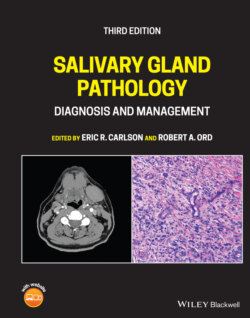Читать книгу Salivary Gland Pathology - Группа авторов - Страница 122
Treatment of Chronic Bacterial Parotitis
ОглавлениеTreatment of chronic bacterial parotitis centers on palliative therapy with parotidectomy reserved as a last resort (Figure 3.10). Effective treatment is centered on the gland inflammation as well as the precipitated intraductal material. Patients should be treated with culture‐specific systemic antibiotics, ductal antibiotic irrigations during periods of remission, analgesics, and avoidance of dehydration and anti‐sialogogue medications (Goldberg and Bevilacqua 1995). The identification of a sialolith should result in expedient removal. Sialendoscopy represents a technique that may obviate the need for aggressive surgical intervention (Nahlieli et al. 2006; Hasson 2007). Sialendoscopy is a minimally invasive procedure with a low rate of complications. A Danish study published in 2016 demonstrated a 26% reduction in the number of salivary gland excisions for benign processes after the introduction of sialendoscopy in 2004 compared to the five years prior (Rasmussen et al. 2016). Sialendoscopic findings of patients with chronic obstructive parotitis include ductal stricture, mucous plugs, and desquamative epithelial cells and inflammatory cells (Qi et al. 2005). A sialendoscopic procedure may address any or all of these problems, thereby sparing the gland (Figure 3.11). If pain and swelling become intolerable for the patient, or if special imaging studies reveal abscess formation in the parotid gland, then nerve sparing parotidectomy is the treatment of choice (Figure 3.12)
van der Lans et al. (2019) retrospectively reviewed 46 parotidectomies performed on 37 patients with chronic bacterial parotitis. Total parotidectomy was performed in 41 cases (89%) and superficial parotidectomy was performed in 5 cases (11%). No information was included in this report regarding the chronicity of symptoms, nor the type of symptoms in their cohort. Temporary paresis of the facial nerve was noted in 12 operations (26%) with a mean duration of 7.7 weeks, with no incidence of permanent paresis. Frey syndrome was noted after 20 parotidectomies. Recurrence of the parotitis was noted in six cases (15%) and was successfully treated with conservative measures in four patients. The authors concluded that parotidectomy is a safe and effective means to resolve chronic recurrent parotitis. These authors did not find differences in resolution of disease between superficial parotidectomy and total parotidectomy. Therein, they indicated that successful treatment is realized in removal of as much affected glandular tissue as possible while identifying and preserving the facial nerve.
Figure 3.9. A left facial abscess in a 45‐year‐old man with a two‐week history of left facial swelling and pain (a). Computerized tomograms (b and c) demonstrate an abscess within the tail of the left parotid gland. The patient underwent incision and drainage (d) in the operating room for a diagnosis of community acquired acute bacterial parotitis with abscess formation. Methicillin‐resistant Staphylococcus aureus species were cultured. He showed resolution of his disease at two months postoperatively (e and f).
Figure 3.10. Algorithm for the management of chronic recurrent bacterial parotitis.
Figure 3.11. The miniature endoscope for diagnostic and interventional sialendoscopic procedures (a – Karl Storz Endoscopy, Germany). The instrumentation seen here is utilized for diagnostic procedures only. The endoscope may be connected to an operating sheath for interventional procedures (see Chapter 5). A series of duct dilators (b) are inserted in Stensen duct prior to placing the sialendoscope (c). A representative image is noted in (d) that demonstrates normal findings in a patient with chronic parotid pain. The sialendoscopy procedure, including dilatation and irrigation of the duct, resulted in resolution of symptoms. A 76‐year‐old man with a chronic history of right parotid swelling that waxed and waned (e–g) and he was noted to have the forced expression of pus from right Stensen duct (h). He underwent imaging studies (i and j) due to the chronicity of his diagnosis of chronic parotitis. A sialendoscopy was performed (k) that identified thick mucus in his main Stensen duct (l) and strictures in his distal ductwork within the gland (m).
Figure 3.12. A 35‐year‐old man with a two‐year history of left parotid pain and swelling (a and b). Computerized tomograms (c) showed sclerosis of the parotid parenchyma as well as a suspected abscess. The patient underwent left superficial parotidectomy with a clinical and radiographic diagnosis of chronic bacterial parotitis with abscess formation. The superficial parotidectomy was accessed with a standard incision (d). A nerve sparing approach was followed (e) that allowed for delivery of the specimen (f). Histopathology showed chronic sialadenitis with abscess formation (g). The patient displayed resolution of his disease at three years postoperatively (h and i) he displays resolution of his disease.
